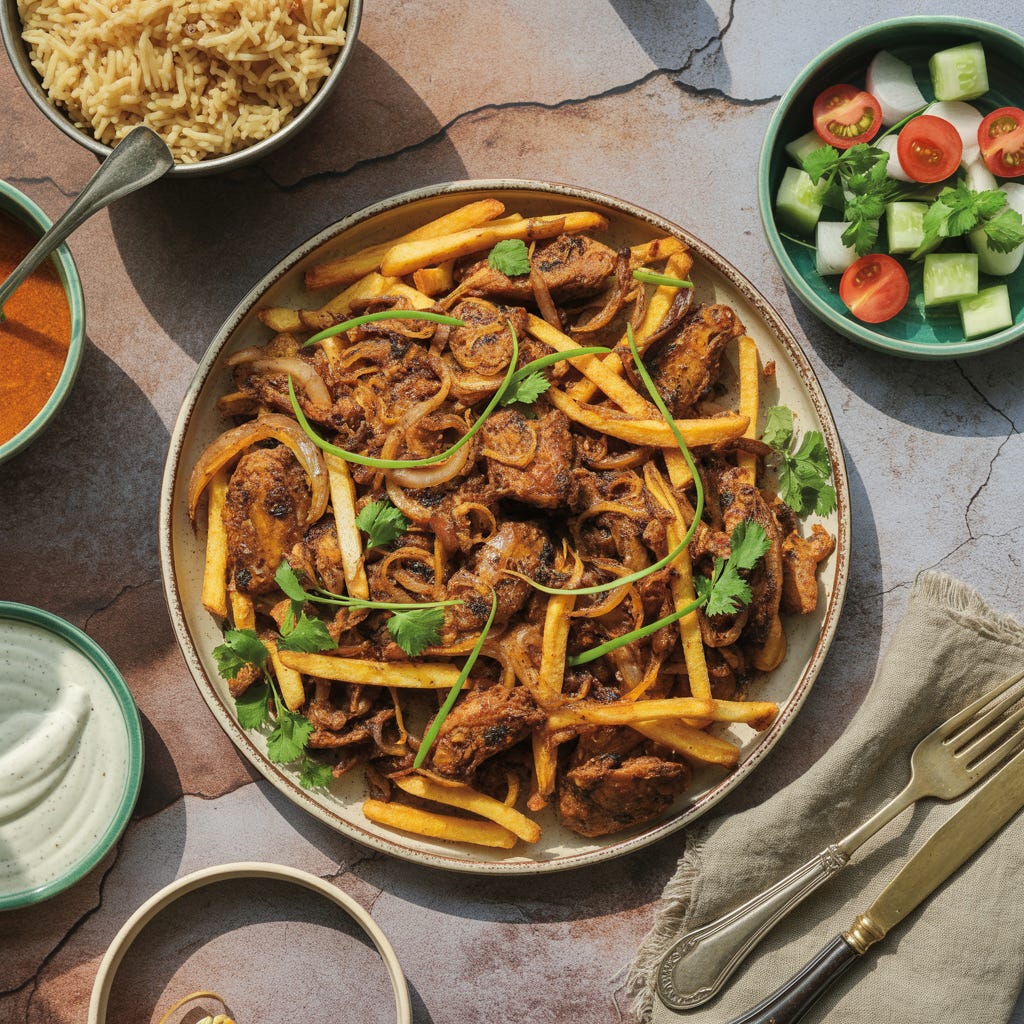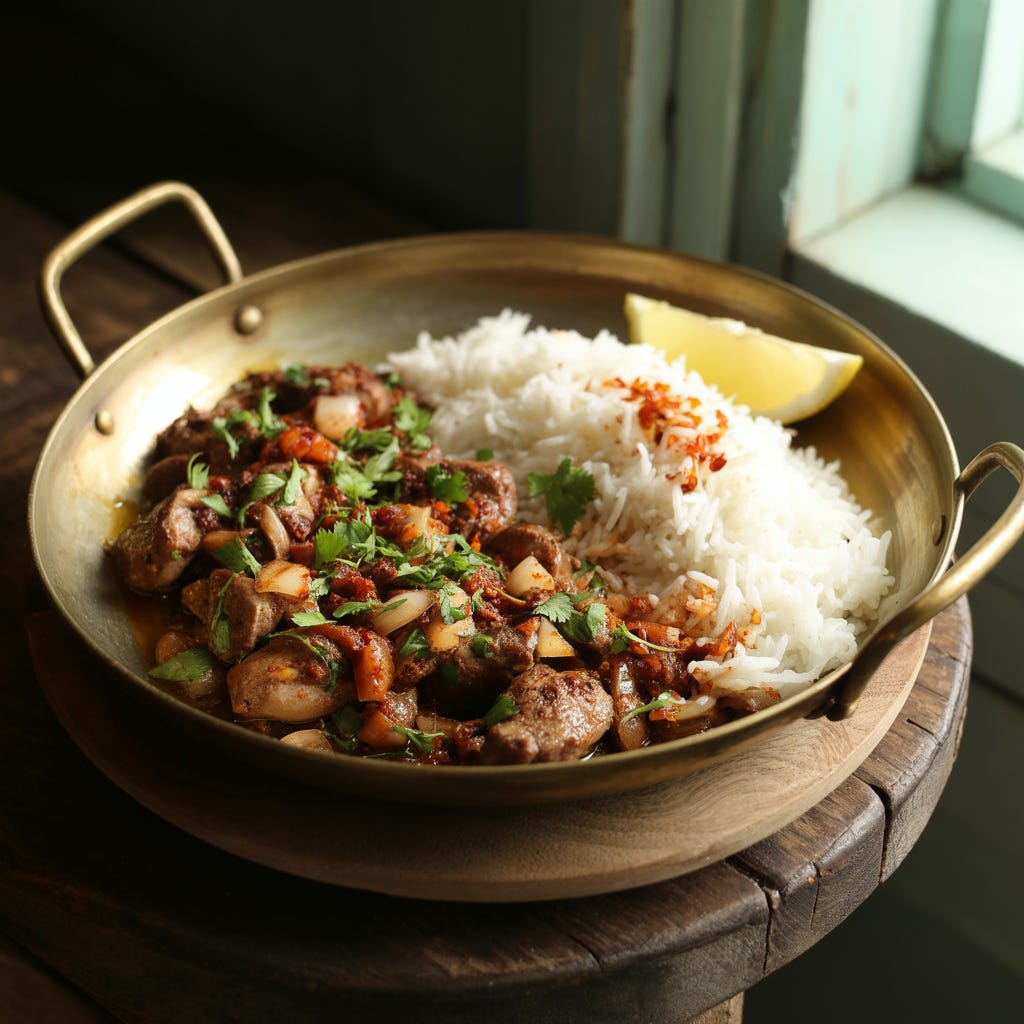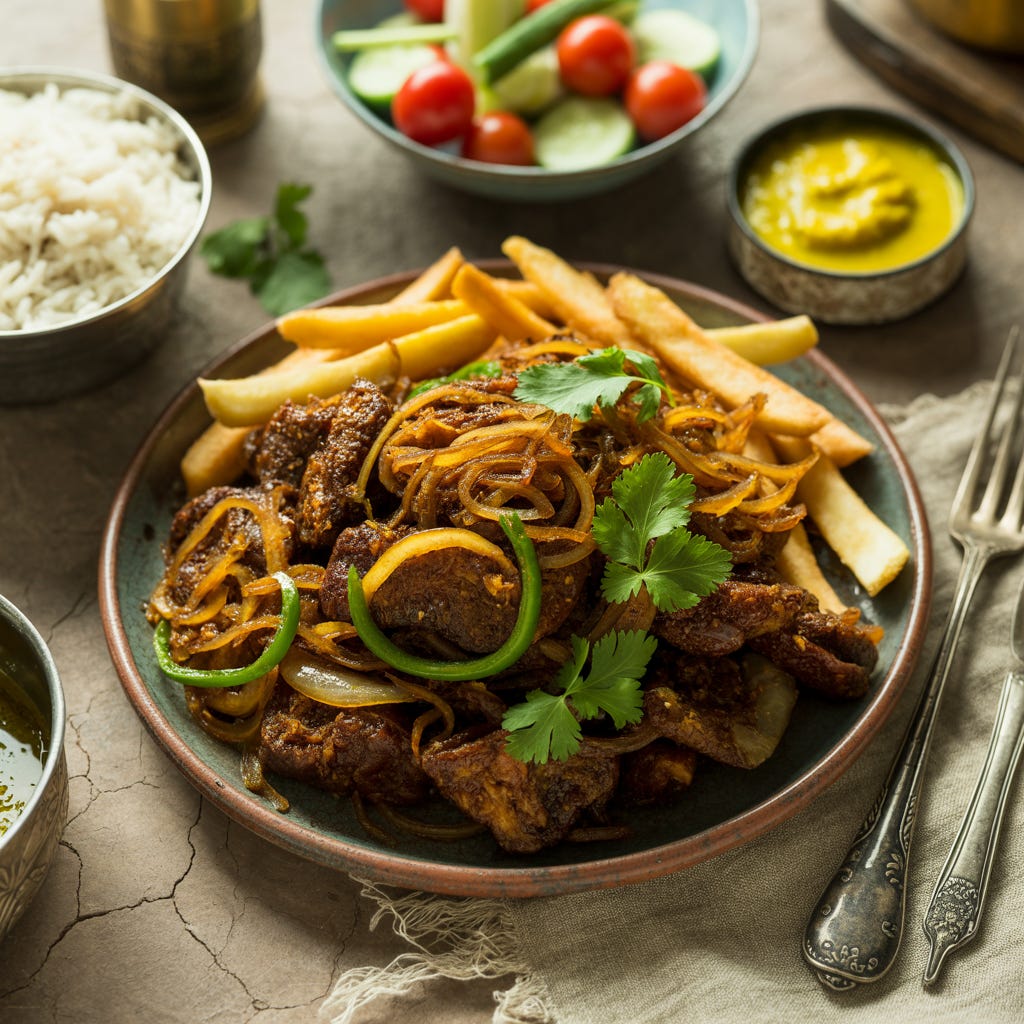By Elli Benaiah
I’ve always thought offal was awful. The very word sounds like a warning.
And yet, Jewish kitchens have a strange relationship with liver. Especially kosher ones, where liver undergoes a ritual exorcism involving salting, grilling, draining, and frying until it’s no longer just dead—it’s gone. Executed three times over.
It’s the Dead Parrot Sketch from Monty Python, re-enacted in a frying pan:
“This liver is no more!
He has ceased to be!
It`s metabolic processes are now history!
THIS IS AN EX-LIVER!”
As a kid, I made it work. My brother got the livers. I took the chips they were fried with. A trade agreement sealed in sibling diplomacy.
The recipe that made this barter possible was what we called kaleji.
Kaleji: Not Your Grandma’s Chopped Liver
In Calcutta, It was called it kaleji—from the Hindi/Urdu/Bengali word for liver—and it was treated with flavour, not fear.
Our version wasn’t the "Awafi" style you find in the Australian Jewish Indian community cookbook. That one is dignified, mild, and polite—a restrained ensemble of paprika, lemon juice, and sweet chili sauce.
Worthy of its place at a bridge table and similar to Aunt Rahele`s version (below)
We’ll get to that one later.
By the way, “Awafi” is the Arabic (عوافي) means health, good fortune. It’s what you say when serving food—a wish that the meal does more than just fill the stomach. That it lingers in the soul.
Our kaleji was more streetwise. More soul. More sizzle.
Fried onion rings, ginger-garlic, turmeric, coriander, cumin, a hit of chili powder. Then, in go the livers. I add a drizzle of amba for extra flavour, and a scattering of fresh-fried chips. The amba would caramelize into the fry, and the chips would soak up the masala. We’d eat it hot, over plain white rice with a side of zalata.
At Numnum, the restaurant I once ran in Basel, we served chopped liver, the Ashkenazi way. I really don`t want to knock it, mine was good with loads of fried onions and a drizzle of silan, date molasses.
But we also served it with a Sephardic twist: a Jerusalem-style grill mix with Jewish-Baghdadi-Bengali attitude. It was loved, in Switzerland. No mean feat.
But kaleji wasn’t just ours.
In Bengal: Kaleji as Eid Breakfast
In Bengal, olija bhuna or bhuna kaleji is a beloved Eid-ul-Adha morning ritual in Muslim communities.
Imagine the sizzle of onions in hot oil, the air thick with the pungent perfume of browning onions, ginger, and garlic. In the Bengali Muslim neighbors' kitchens, kaleji wasn’t just food; it was an event.
Especially on the day after the ritual animal sacrifice, the breakfast menu was a given: kaleji and parathas.
The ritual started with mustard oil, sharp and nutty, followed by dancing spices: bay leaf, cardamom, cinnamon. A mountain of onions went in, then ginger-garlic, and finally goat or beef liver. Ground spices followed—cumin, coriander, turmeric, and fiery red chili.
The aroma was irrestible, so - if you can`t beat them, join them. In Jewish communities, chicken livers were used.
The trick, as every auntie insisted, was to “fry it hard and fast” to keep the liver moist and velvet-like. Cooked too long, it turned grainy.
Some families added cubed potatoes—the part I adored most as a child. In my family it was french fries. Soft and spice-drenched, were worth fighting over, and bartering for.
Bhuna kaleji is dry, rich, and intensely aromatic. You could scoop it with flaky paratha or mix it into rice. It was celebratory food, yes—but now also ancestral. Liver as heritage.
A Meeting of Worlds: Baghdadi Jewish Kaleji, 3 ways
It was only years later, in London, that I discovered our family’s kaleji wasn’t unique. I met Sima, a British Jewish woman whose family had lived in Kolkata. One rainy afternoon, we swapped childhood food stories.
“We make that too!” she beamed. And just like that, in my mind`s eye I was standing in her mother’s kitchen watching another version of my childhood being cooked.
Her family called it "Awafi" kaleji. The cooking began the same way: onions, garlic, and ginger sizzling in oil. But the rest veered gentle: sweet chili sauce, soy sauce, chopped coriander.
Aunt Rahele offers her take. Kaleji is liver. I have made liver over the years. Not too often too tedious.
To prepare kosher chicken livers you devein them first and then wash and salt them in a colander. When completely dry you grill them which is what it takes to make them for eating. You can even do it on the bbq (with nothing else added to it except a little more salt). She serves it on a small round pita where the guests could then place the liver and then the onions (sliced very thin) and chillies and a little lemon.
So simple, so satisfying.
After the grilling you can make it into chopped liver or a curry.
Here it is for comparison:
Awafi-Style Chicken Liver (Serves 4)
Ingredients:
300 g chicken livers
1 large onion, sliced
1 large tomato, sliced
½ tsp crushed garlic
½ tsp crushed ginger
2 tbsp sweet chili sauce
1 tsp soy sauce
½ tsp paprika
1 tsp lemon juice
1 tbsp tomato sauce
½ cup chopped coriander or celery leaves
3 tbsp oil
Salt & pepper to taste
Method: Grill chicken livers with salt and pepper and drain. In a frying pan, heat oil and fry onions until golden. Add tomatoes, ginger, and garlic. Stir in livers and remaining ingredients. Cook until tender. Serve with rice.
and now the kaleji epitome (in my opinion, anyway)
Baghdadi Calcutta Kaleji with French Fries (Serves 4-ish)
Ingredients:
400–500g chicken livers, cleaned
2 onions, sliced into rings
1 tbsp ginger-garlic paste
2 tsp ground cumin (zeera)
3 tsp ground coriander (dhaniya)
1 tsp chili powder
½ tsp turmeric
1.5 tsp. Salt, or to taste (with a light hand, the liver is already well salted)
optional: 1 tsp amba (fermented mango pickle sauce)
A handful of thin potato chips (homemade)
Oil for frying
Method:
Fry onion rings in oil until golden.
Add ginger-garlic paste and hamiss it, stir until fragrant.
Add spices: cumin, coriander, chili, turmeric. Cook briefly.
Add liver, fry on high heat until just cooked.
Add salt and a splash of the optional amba.
Separately fry chips until crisp. Toss into liver.
To serve: Over white rice with zalata, or stuffed in warm pita.
and the recipe, in full livery
The Last Word
Where chopped liver is subdued and beige, kaleji is bold.
It doesn’t apologize. It doesn’t whisper nostalgia—it sizzles it.
Kaleji kicks. Awafi and Shabbat Shalom






